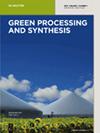Green polymer electrolyte and activated charcoal-based supercapacitor for energy harvesting application: Electrochemical characteristics
IF 3.8
4区 工程技术
Q2 CHEMISTRY, MULTIDISCIPLINARY
引用次数: 0
Abstract
The aim of this study is to address the growing concern about microplastics in the ocean and their potential harm to human health through ingestion. The MPs issue is largely a result of the increasing demand for electronic devices and their components. To tackle this challenge, the research aimed to develop a green polymer electrolyte that used glycerol as a plasticizing agent to improve ionic conductivity. The polymer host included chitosan and polyvinyl alcohol and was composed of sodium acetate. To evaluate the performance of the polymer electrolyte, various analytical techniques were used, including impedance and electrochemical studies. The ionic conductivity of 7.56 × 10−5 S·cm−1 was recorded. The dielectric property study confirmed the ionic conduction process in the system and revealed the existence of non-Debye type relaxation, as indicated by asymmetric peaks of tanδ spectra. The alternating conductivity exhibits three distinguished regions. The polymer electrolyte was discovered to be electrochemically stable up to 2.33 V and capable of storing energy as a non-Faradaic electrochemical double-layer capacitor (EDLC). The cyclic voltammetry pattern is a leaf like shape. The EDLC was able to be charged and discharged up to 1 V, and it showed cyclability and could be used in low-voltage applications.基于绿色聚合物电解质和活性炭的能量收集应用超级电容器:电化学特性
这项研究旨在解决人们日益关注的海洋中的微塑料及其摄入对人类健康的潜在危害问题。微塑料问题在很大程度上是由于对电子设备及其组件的需求日益增长造成的。为应对这一挑战,该研究旨在开发一种绿色聚合物电解质,使用甘油作为增塑剂来提高离子导电性。聚合物宿主包括壳聚糖和聚乙烯醇,并由醋酸钠组成。为了评估聚合物电解质的性能,使用了各种分析技术,包括阻抗和电化学研究。记录到的离子电导率为 7.56 × 10-5 S-cm-1。介电性能研究证实了体系中的离子传导过程,并揭示了非德拜型弛豫的存在,如 tanδ 光谱的不对称峰所示。交变导电性呈现出三个不同的区域。研究发现,这种聚合物电解质的电化学稳定性高达 2.33 V,能够作为非法拉第电化学双层电容器(EDLC)储存能量。循环伏安模式呈树叶状。EDLC 的充放电电压可达 1 V,具有循环性,可用于低压应用。
本文章由计算机程序翻译,如有差异,请以英文原文为准。
求助全文
约1分钟内获得全文
求助全文
来源期刊

Green Processing and Synthesis
CHEMISTRY, MULTIDISCIPLINARY-ENGINEERING, CHEMICAL
CiteScore
6.70
自引率
9.30%
发文量
78
审稿时长
7 weeks
期刊介绍:
Green Processing and Synthesis is a bimonthly, peer-reviewed journal that provides up-to-date research both on fundamental as well as applied aspects of innovative green process development and chemical synthesis, giving an appropriate share to industrial views. The contributions are cutting edge, high-impact, authoritative, and provide both pros and cons of potential technologies. Green Processing and Synthesis provides a platform for scientists and engineers, especially chemists and chemical engineers, but is also open for interdisciplinary research from other areas such as physics, materials science, or catalysis.
文献相关原料
| 公司名称 | 产品信息 | 采购帮参考价格 |
|---|
 求助内容:
求助内容: 应助结果提醒方式:
应助结果提醒方式:


